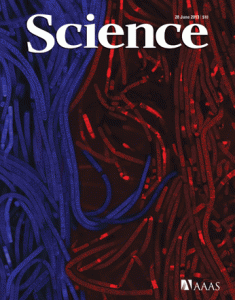Congratulations to ICaMB and CBCB researchers Soren Nielsen, Yulia Yezenkova and Nikolay Zenkin and who have a paper published in the prestigious journal Science today.

Nikolay Zenkin: RNA Polymerase researcher
There are three RNA Polymerases in Eukaryotic cells and although much attention focuses on the role of RNA Polymerase II, since it transcribes mRNAs from protein encoding genes, it is easy to forget that the majority of transcription in the cell is accomplished by RNA Polymerase III. RNA Polymerase III (or Pol III as it is commonly known) is responsible for the synthesis of ribosomal 5S rRNA, tRNA and other small RNAs.
Soren’s paper, entitled “Mechanism of Eukaryotic RNA polymerase III Transcription” termination solves a long-standing mystery in the field of how transcriptional termination by RNA polymerase III takes place. Their study reveals an elegant scenario, in which co-transcriptional folding of highly-structured RNA polymerase III transcripts causes termination at the end of their genes. This mechanism ensures proper folding of the structural/catalytic RNAs synthesized by RNA polymerase III prior to RNA release. Analogies with bacterial termination suggest that this fundamental mechanism may have emerged before divergence of bacteria and eukaryotes.
Here is the Science Editor’s summary of the paper
It is as important to terminate any biological process as it is to start it. Transcription, copying information encoded in genes into RNA, requires accurate and timely termination. Nielsen et al. (p. 1577) present a mechanism for transcription termination by RNA polymerase III, the enzyme that synthesizes the majority of RNA molecules in eukaryotes. In this scenario, the folding of the RNA as it is transcribed by polymerase into a highly structured transcript causes termination at the end of its synthesis. This mechanism may serve as a control of proper folding of structural or catalytic RNAs synthesized by RNA polymerase III. Comparison with other organisms suggests that this mechanism emerged before divergence of bacteria and eukaryotes.
And here is the abstract of their paper
Gene expression in organisms involves many factors and is tightly controlled. Although much is known about the initial phase of transcription by RNA polymerase III (Pol III), the enzyme that synthesizes the majority of RNA molecules in eukaryotic cells, termination is poorly understood. Here, we show that the extensive structure of Pol III–synthesized transcripts dictates the release of elongation complexes at the end of genes. The poly-T termination signal, which does not cause termination in itself, causes catalytic inactivation and backtracking of Pol III, thus committing the enzyme to termination and transporting it to the nearest RNA secondary structure, which facilitates Pol III release. Similarity between termination mechanisms of Pol III and bacterial RNA polymerase suggests that hairpin-dependent termination may date back to the common ancestor of multisubunit RNA polymerases.
Links
Link to the Science paper: http://www.sciencemag.org/content/340/6140/1577.abstract
Nikolay Zenkin laboratory home page: http://www.ncl.ac.uk/camb/staff/profile/nikolay.zenkin#tab_research
Centre for Bacterial Cell Biology: http://www.ncl.ac.uk/cbcb/
Science magazine: http://www.sciencemag.org/
Link to the Science cover: http://www.sciencemag.org/content/340/6140.cover-expansion

